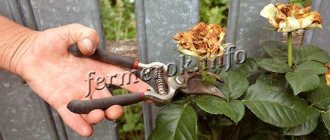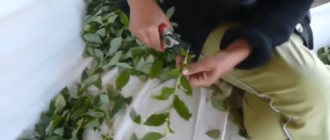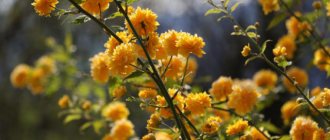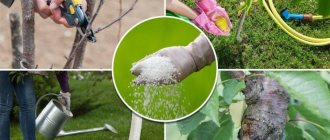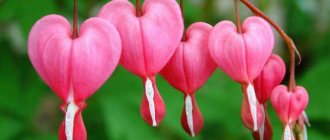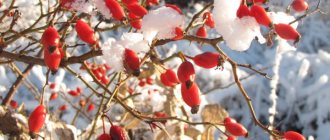Description
Viburnum Bouldenezh (Viburnum Boule de Neige) is a variety of common viburnum.
The variety was bred in France and brought to Russia by Catherine II. The height of the fast-growing crop ranges from 1.5 to 3.5 meters. The annual growth is 30-40 cm. It grows actively until the age of seven; at ten years of age, growth slows down or stops completely. The spreading spherical crown of the bush gives this crop a decorative appearance even after flowering. Carved leaves of light green color acquire a crimson tint in autumn. The shape is similar to maple.
In early summer, the plant is covered with white inflorescences in the shape of a ball, the diameter of each varies from 7 to 15 cm. The flowers have no aroma. Flowering lasts about 4 weeks. The older the viburnum is, the more abundant its flowering. Often, under the weight of the inflorescences, the branches bend to the ground.
Viburnum Buldenezh is a long-liver and can delight with its flowering for 60 years in a row.
How to renew a viburnum bush. Description of viburnum
In terms of biology, viburnum is a very interesting culture, take the family for example: initially, botanists assigned viburnum to the Honeysuckle family, based on a number of morphological characteristics, although if you look at honeysuckle and viburnum, everyone will be surprised: they have absolutely nothing in common. At the beginning of the 21st century, viburnum was transferred to another family - Adoxaceae, but from there, after much debate and litigation, it was decided to exclude viburnum. Now the viburnum has been separated into an independent family - the Viburnum family, and now its status will apparently remain unchanged.
Viburnum is widespread almost everywhere, it especially likes to occupy wet soils, near rivers, swamps, it grows in open areas and is often overgrown with overgrowing shoots so much that the yield from each bush does not exceed a kilogram and it is sometimes located very high. The berries of wild viburnum hang on the shoots for a long time and burn like rubies, which attracts birds, especially waxwings, which spread this shrub by “sowing” the seeds.
Of the variety of species of viburnum, the exact number of which has not yet been named, only the common viburnum or red viburnum (Viburnum opulus) is the most widespread in cultivation. This species is considered by some to be a shrub, by others – a low tree, but still, biologically, the common viburnum is closer to a shrub.
The leaf blades of this species are opposite, less often whorled, the plant is deciduous. The inflorescences of the common viburnum are umbellate-corymbose, consisting of a number of asexual, large flowers that bloom a day or two before the others in the inflorescence open and serve solely to attract insects. Viburnum is almost completely self-sterile; pollen of other varieties is needed for pollination, but the pollen itself is so small and light that it is sometimes carried by the wind for kilometers, so often even a lonely viburnum bush in the middle of the steppe is covered with fruits.
By the way, about the fruits of viburnum, these are drupes, bright red in color, becoming soft as they ripen, with an abundance of juice and almost imperceptible pulp. The taste, even of modern varieties of viburnum, is quite bitter, so the berries are usually frozen before use, which somewhat reduces the bitterness. Inside each berry there is a very large, flat seed, sometimes occupying up to a third of the weight of the berry.
Viburnum is a real long-liver; in good nutritious soil, in a well-lit place, with a caring owner it can live for decades. Officially, its productive age is limited to 30 years, but if the viburnum is rejuvenated by cutting off all the shoots onto the stump, it can be doubled.
Types and varieties
There are two varietal varieties of viburnum Buldenezh.
Decorative
It differs from the ordinary one only in its smaller size, the maximum height of the bush is 2 meters. Despite its small “growth”, it has a spreading crown, the diameter of which reaches 4 meters. With proper care, shoot growth annually is about 40 cm. The variety is frost-resistant and easily adapts to regions with cold climatic conditions.
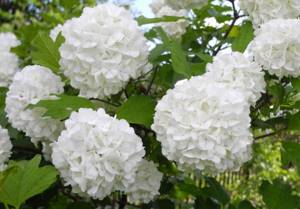
Roseum
A tall variety of viburnum Buldenezh with double flowers. The maximum height of an adult crop is 4 meters, the diameter of its crown is the same. Large shoots rush upward. They have many horizontal side branches that hang down during the flowering period under the weight of the inflorescences. The leaves are three- or five-lobed, rich green in color, becoming orange-red in the fall. Flowers change color at the end of flowering: a greenish tint turns into pinkish.
Planting seedlings
When planting viburnum seedlings Buldenezh, you need to take into account that in the open sun the flowers will dry out faster, and in constant shade the plant will bloom later. Also, when growing, you need to pay attention to the soil, it must be quite fertile.
Disembarkation dates
It is better to plant viburnum in the spring; it is not recommended to do this in the fall - unexpected frosts and heavy rain will destroy the young plant. It needs to be planted in dry, warm weather.
Selection of a location on the site
The plant prefers to grow in moist, loose soil - in the lowlands, near water bodies. Viburnum has a spreading crown, so it needs to be grown where it will not interfere.
Technique for planting viburnum Buldenezh
Procedure for planting seedlings:
- Dig a hole large enough for the root system of the cutting.
- Add nutritious minerals and fertilizers to the pit.
- Add mixed sand, charcoal, peat.
- Fill the hole so that the ground is moist but there is no puddle.
- Trim the roots so they will grow faster.
- Plant the seedling and cover it with soil so that it stands stable.
- Tie and water.
How to care
The aristocratic viburnum Buldenezh is hardy and undemanding in care. It is especially popular among gardeners. The frost-resistant perennial is grown in various regions of our country; viburnum has taken root even in Siberia and the Urals. Simple rules for planting and caring will help even beginners in gardening to grow ornamental shrubs.

Soil selection
Soil fertility is the key to abundant flowering of viburnum. Soil acidity should not be higher than 6.5. If the indicator is higher, the soil substrate must be treated with a lime solution. Ground ventilation should be ensured. To do this, it is enough to periodically loosen the top soil layer. When planting crops in heavy, dense soil, it is recommended to add sand.
Location and lighting
The perennial flowering shrub prefers to grow in a lighted area. A little shading will not affect the flowering of the plant. The ideal place for planting is near the wall of the house, fence, next to the gazebo. Viburnum does not like to grow on a hill; a slope or lowland without stagnant water is preferable for it.
If it is possible to plant viburnum near a pond, then this should definitely be done. For a moisture-loving culture, such a neighborhood is the most favorable. An important condition for this is the laying of a drainage layer in the planting hole, which will prevent water stagnation.

Temperature, humidity, watering
The frequency of watering depends on the age of the plant and weather conditions. During the rainy summer, viburnum will receive enough natural moisture. In dry summers, watering should be regular and abundant. An adult bush is watered 2-3 times a month (water volume - 50 liters), a young one - 2-3 times a week (two buckets of water). Watering is carried out in the evening with warm water; you can place containers to heat the water in the sun.
Mulching will protect the soil from drying out: mix sawdust and peat, and cover the surface around the viburnum with the resulting mixture.
In the absence of rain in autumn, Buldenezh also needs watering; the moisture will protect the bush from dehydration.
Fertilizers and fertilizers
For the full development of the crop, fertilizing should not be neglected. Depending on the fertility of the soil there may be one or two.
In the spring, before flowering, it is recommended to apply complex fertilizer for ornamental plants. The mineral composition is applied in dissolved or dry form to the root area. When applied dry, the soil around the plant is loosened and watered abundantly.
You can prepare your own nutritional mixture. For this you will need superphosphate (40 g), ammonium nitrate (25 g), potassium salt (15 g), compost (6-7 kg). The specified ratio of substances in the composition is used to feed one bush.
It is enough to saturate the nutrient soil with organic matter: infuse one part of chicken manure in 10 parts of water. You can prepare an infusion of herbs, which must first be fermented. Water at the root. Humus or wood ash is also suitable as a top dressing.
Transfer
It is not recommended to replant Viburnum Buldenezh before it has grown for two years in its previous location. In two years, the bush will take root and grow a root system, which will facilitate growth in the newly selected area.
Transplantation is done in early autumn or spring. The stages of transplantation are the same as when planting seedlings.
- Dig a planting hole. It should be spacious, since lateral roots quickly develop from the central root. Minimum hole size: depth 60 cm, width 70 cm.
- Place drainage at the bottom. They use tree bark (chopped into pieces), expanded clay, and small crushed stone. Drainage will prevent stagnation of water, which the viburnum root system does not tolerate well.
- Pour about 30 kg of humus onto the drainage. Mix the compost with phosphorus fertilizer, wood ash, they are also added to the hole. If the soil is heavy, it is diluted with coarse sand.
- Pour 2 buckets of water into the hole. After most of the water has been absorbed, the seedling is placed in the mud. All the roots are covered with earth, leaving no voids around them. The seedling should be at the same height as it grew previously.
- Carefully cover the seedling with the remaining soil and compact it. Water again.
- It is recommended to mulch the tree trunk circle with sawdust or humus.
Trimming
Viburnum Buldenezh needs annual pruning. Each stage of plant development must be accompanied by certain manipulations:
- All unopened inflorescences are removed from a one-year-old seedling. At the end of summer, young shoots are partially pinched so that the crown is formed lush;
- In a two-year-old bush, shoots located below 20 cm from the soil are pruned;
- Every year in the spring (before flowering), damaged branches are cut out - dried, broken, weakened;
- the crown is formed after flowering, when the plant has reached a height of 1.5 meters. It can be shaped into a ball, triangle, or standard.
Pruning is carried out until mid-summer so that the viburnum regains its strength before winter.
Winter care
Before frost, viburnum needs to be watered and fed with organic fertilizers. It is not recommended to apply fresh manure.
Mature plants do not need shelter. The tree trunk soil around young bushes should be mulched with compost. Additionally, “insulate” with sawdust or pine needles.
When to prune viburnum
Pruning is an operation that traumatizes the plant, so it is carried out during the dormant period, when there is no sap flow. This phase begins after leaf fall and ends before bud break in the spring. This means that you can prune viburnum in the fall, all winter and early spring. In winter we go out into the garden extremely rarely; in early spring the area is still damp; we open the summer season when it is already warm and everything around is blooming and fragrant. Therefore, the best time for pruning may seem to be autumn - best for you, but not for viburnum.
There are three types of pruning:
Each one needs to be done in its own time.
Video: caring for viburnum, shaping and pruning
What branches can be pruned in the fall?
Winter is ahead, and we never know in advance how much snow will fall, how cold it will be. Accordingly, we cannot predict how the viburnum will overwinter, which branches or buds will freeze, or how many of them will be broken by the wind and heavy snow. It may turn out that you cut off half of the branches in the fall, and winter completed this process with its own methods, as a result of which the entire bush froze. Therefore, do not carry out any thinning pruning in the fall. Let the viburnum overwinter as a lush bush or tree. The branches as a whole will protect each other from winds and cold.
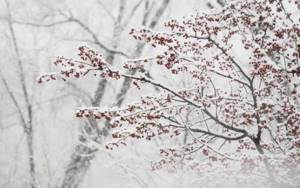
Snow lingers on thick branches; it serves as a warm blanket, but in large quantities it can break branches that are fragile from frost.
In the fall, cut out only what you will not leave anyway - diseased, dried and broken branches, that is, do sanitary pruning. Dried and diseased branches can be easily distinguished from healthy ones by their bark; it is dull, wrinkled, and sometimes covered with black raised dots. If you scratch with a fingernail, brown dry wood or rot will be exposed; on healthy branches, under the bark there is a green, moist layer - the cambium.

A healthy branch has a green layer under the bark
Cut dry branches to the healthy part, above the bud, directed outward, not inward, of the bush.
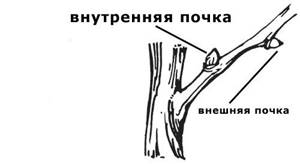
If you are shortening a branch, cut above the outer bud.
Remove broken side branches onto a stump. Cover sections with a diameter of 1 cm or more with garden varnish.
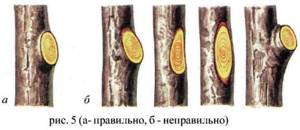
Make the cut parallel to the trunk, departing from it about 3–5 mm
Is pruning necessary in summer?
In summer, viburnum no longer needs only sanitary pruning, but also thinning pruning. In most cases, it concerns the growth of the current year, that is, green shoots. Cut:
- shoots growing from the ground. The sooner you cut off excess root shoots, the more energy the viburnum will have to lay and ripen next year’s buds;
- tops. If you cut a branch incorrectly and leave a large stump, then a whole bunch of fattening shoots oriented vertically—tops—can grow from it. They need to be removed;
- tops damaged by pests and diseases. Viburnum is often affected by aphids, leaf beetles and powdery mildew. Both pests and pathogenic fungi settle on young and tender leaves, which, as you know, are located at the tops of the branches. At the first signs, cut off and burn the foci of infection - the leaves with the tips of the branches, and then treat the entire bush for parasites.
You can prune mature branches and last year's growths in the summer if they were broken, for example, by wind or hail.
Video: fertilizing, watering, spraying viburnum
Pruning in spring
In early spring, before the buds open, all three types of pruning should be carried out. As part of the sanitary process, in addition to diseased and broken branches, we will now also have to remove frozen ones. They look dry (which they are) and are cut in the same way: onto a stump or above a healthy outer bud.
An adult bush or tree needs thinning pruning, remove:
- second-order shoots (lateral branches) growing vertically upward (tops);
- twigs growing inside and down the bush;
- branches crossing and rubbing against each other - leave the strongest and most beautiful of them, and remove the second;
- umbrellas left over from berries.
Video: pruning viburnum in spring
The third type of pruning, shaping, is necessary for young viburnum. You can create any shape of bush or tree. Spring is the most suitable time for this event.
Reproduction methods
There are three ways to propagate viburnum Buldenezh.
Cuttings
A young shoot with several dormant buds is used as planting material. After the viburnum blooms, the shoot is cut off and placed in a growth stimulator for 7-8 hours.
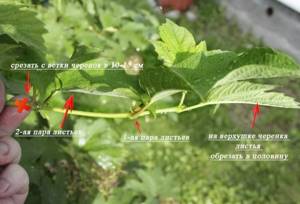
The cutting is planted in a hole with nutritious soil and covered with a plastic bottle or jar to create a greenhouse microclimate. Water moderately. When leaves appear, the covering material is removed. Over the summer, the young seedling will grow stronger, grow roots, and overwinter without any problems. It is transplanted to a permanent place in the spring.
By layering
Select a young shoot growing close to the ground, bend it to the ground, placing it in the prepared groove. Pin with wire, sprinkle with fertile soil. Irrigate regularly with water. Separate the young seedling from the mother plant after rooting.
Dividing the bush
A strong, developed stem is separated from an overgrown bush with a sharp shovel and planted in a new place. You can dig up the entire bush and divide it into two or three parts. Sprinkle the cut areas with charcoal.
Propagation of viburnum by seeds is impossible; the flowers of the sterile variety Buldenezh do not have a pistil or stamens.
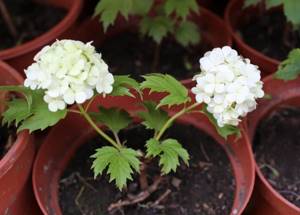
Possible problems
The bush is “falling apart”
The reason is abundant flowering. In the spring you need to trim off excess shoots or shorten their height and remove shoots. During flowering, place supports under the branches so that they do not break under the weight of the inflorescences. You can carefully tie the bush in a circle with wire.
Leaves and flowers fade and turn black
The reason is the appearance of insect pests or powdery mildew. Viburnum should be treated with insecticides.
Viburnum has lost its decorative effect after flowering
You can trim off the faded buds or be patient and wait for the rain and wind to do the job for you.
Diseases and pests
Timely thinning of the viburnum bush is an effective preventive measure against diseases and pests.
Rainy weather often causes perennial disease. Preventive spraying of ornamental crops with tobacco or garlic-onion solution will protect it from diseases such as powdery mildew, spotting and gray rot. If the disease is detected, treatment with special preparations is necessary: “Hom”, “Abiga-Pik” and others.
Insect pests also pose a threat: black aphids, viburnum leaf beetles, cap moths, and scale insects. Two or three times treatment (with a ten-day interval) with insecticides (Inta-Vir, Karbofos, Iskra, Fufanon) will help destroy uninvited guests.
Caring for viburnum buldenezh in spring after winter
In the spring, as soon as the snow melts and warm weather sets in, the shrub needs to be prepared for beautiful flowering, because there is not much time left for this. First of all, old dried and frozen shoots directed towards the center of the bush are removed from the bush.
Then they loosen the soil in the root circle and fertilize. The first feeding of viburnum is carried out with a complex fertilizer for flowering shrubs, which should include potassium, phosphorus and nitrogen. If you are against mineral fertilizers, they can be replaced with wood ash, compost or well-rotted manure. This mixture is mixed well and spread on the root circle, and then watered generously. The volume of the organic mixture should be 1.5-2 buckets per 1 bush.
During the flowering of viburnum Buldenezh in dry weather, the bush must be watered regularly. Only then will the bush bloom beautifully and luxuriantly.
In addition, in early spring, preventive spraying of the bushes against possible pests and diseases is carried out. Viburnum Buldenezh, unlike other fruit trees and berry gardens, is practically not affected by diseases or pests.
Aphid
Aphids love viburnum very much. This is the most dangerous of pests. It settles on berry and ornamental bushes, feeding on the juice of young leaves. As a result, the plant gets sick, its decorative appearance decreases and the plant may even die. For prevention purposes, it is necessary, first of all, to regularly inspect the bushes. When the first insects are detected, control measures must be started immediately.
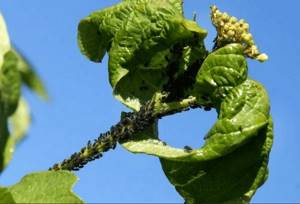
- Treat the bush with a solution of laundry soap. To prepare the solution, grate a pack of laundry soap, pour 2 liters of warm water into the shavings and stir until the soap dissolves. Then the volume is brought to 10 liters with cold water, the solution is left for several hours so that it settles and becomes transparent. And after that, the bush is sprayed with a soap solution, trying to get the product on the underside of the leaves.
- A solution of ammonia also helps to cope with aphids. To do this, add 4 tbsp to 10 liters of water. l. ammonia and, as an adhesive, liquid soap - 4 tbsp. l. Stir well and spray the bushes. Repeat treatment after 2-3 weeks.
This treatment can be carried out for preventive purposes in early spring, as soon as the snow melts in the garden.
- Scatter wood ash around the tree trunk. It will not only repel voracious pests, but will also serve as fertilizer.
- If the aphid infestation is quite significant, treat the shrub before it begins to flower with solutions of Agrovertin, Actellik, Bitoxyclicin or Inta-vir. During flowering, treatment with chemical insecticides is not recommended, as this can harm the bees. Spraying is carried out in the evening in calm, windless weather, taking precautions and strictly following the instructions for use.
- Fight ants, because where there are ants, there are aphids.
Viburnum leaf beetle
This insect pest is also extremely dangerous for the plant. In dry, hot summers, the pest begins to actively reproduce and its larvae begin to actively eat away the leaf blade and young shoots.
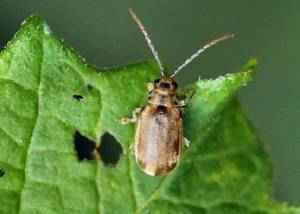
Pest treatment is carried out with insecticides by spraying with Karbofos or Fufanon. The first spraying is carried out no later than mid-May before the first larvae appear. Repeated treatment with such drugs is carried out in August in order to destroy adult individuals.
Powdery mildew
This fungal disease is the scourge of many shrubs, including viburnum Buldenezh. In the fight against the disease, preventive spraying of the plant is carried out as soon as the snow melts on the site.
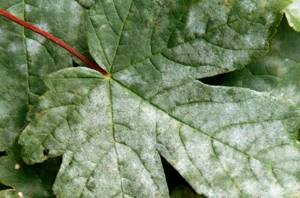
- A solution of soda ash and soap. The first spraying is carried out in early spring, and then after flowering with an interval of 1 week. Prepare a solution: dissolve a pack of laundry or tar soap in 10 liters of warm water, add 10 tbsp. l. food or 5 tbsp. l. soda ash.
- Garlic infusion. To do this, pour 50 g of chopped garlic into 2 liters of warm water and leave for 2 days. Then the infusion is filtered and used for processing.
Use in landscape design
Kalina Buldenezh will fit perfectly into any landscape. Complex compositions can be created with it; it looks no less original in separate plantings and alone in a flowerbed.
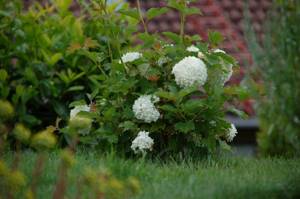
Designers skillfully emphasize the beauty of ornamental shrubs, combining it with dwarf plants. Perennials are planted along paths and borders, near benches and gazebos. Viburnum is becoming increasingly popular among amateur gardeners.
Viburnum Buldenezh does not have medicinal properties, does not produce tasty fruits, but it pleases the soul and delights with its beauty. It’s hard to take your eyes off the snow-white balls of inflorescences. A little effort in caring for an unpretentious shrub and you are guaranteed a fabulous atmosphere in the garden.

Does viburnum need pruning?
Although viburnum has been cultivated, it continues to retain the properties of wild shrubs. Without care, it produces a lot of growth and acquires a large number of side branches. Every year, new shoots strive to outgrow the old ones, reach for the sun, flowering and fruiting go to the tops. And the branches of the lower tier end up in the shade and dampness, become sick and gradually dry out. In a matter of years, viburnum turns into unsightly and barren dead wood.
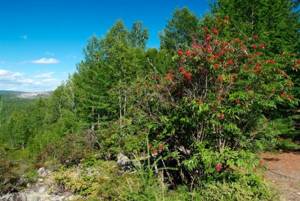
This is what viburnum looks like in nature, without pruning
Meanwhile, with good care, viburnum can maintain an attractive appearance and productivity for 20–25 years. Caring for viburnum is simple: regular watering, fertilizing twice a year and, of course, pruning. The last point is the most difficult, especially for beginners. After all, you need to know when to prune, which branches can be removed, so as not to be left without berries. In addition, there are two situations when a clear action plan is required:
- You bought a seedling and don’t know how to form viburnum from scratch.
- You got a garden with already mature viburnum. How to thin it out or rejuvenate it?
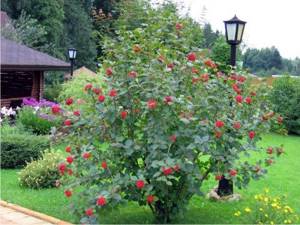
Well-groomed viburnum in the garden pleases the eye
If you crush or bite into a viburnum berry, you will find a seed that looks like a pink heart. So nature itself suggests for what diseases these berries can be consumed. Viburnum juice stimulates the heart, lowers blood pressure, and is a good rejuvenating agent. But it is contraindicated for people suffering from hypotension (low blood pressure).

